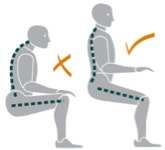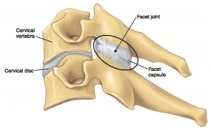The problem
- The vertebra in the neck are attached centrally via the discs and at the top and bottom by the facet joints which lie along the sides of the spinal column.
- With certain movements, the facet joints may be stretched or compressed.
- If these movements involve too much force or are too repetitive, they may lead to injury at the joint.

- Symptoms are generally felt on one side of the neck
- Muscle spasm is a common presentation around the affected joint.
- Pain down the shoulder or into the arm may also be present.
Interesting facts
- The facet joints in the spine are orientated differently dependent on the area of the spine from which they come. This assists with controlling the direction of movement and stability.
- They are only designed to take between 12 and 15% of the weight of the head with the remaining load to be taken by the disc.
Management options
- An irritated cervical facet joint will generally be more painful on leaning or turning toward the side of the injury as well as looking up or movements in which the joint is being compressed.

- Rest from aggravating activities allows the body to repair and settle irritated tissue.
- As a general rule gently stretching forward and away from the pain will stretch and open the joint which can help to settle symptoms and restore movement.
- Heat can be useful to settle muscle spasm associated with the injury
- Anti-inflammatory medication can calm the irritation to the joint and surrounding tissues (consult with your GP).
- Physiotherapy has been proved to assist in restoring normal joint mechanics and speeding up recovery for acute cervical facet joint injuries.
More Information
- Poor posture is a common cause of facet joint injury.
- Avoiding slumped or slouched sitting and standing postures is important to allow the injury to settle.

- Facet joints are commonly irritated as a result of stiffness or restricted movement in the upper back which overloads the joints of the neck.
- This may be as a result of poor postural habits and/or weakness of the core and small stability muscles of the neck.
- In the event of ongoing issues it may be useful to seek advice and manual therapy from your physiotherapist to loosen the stiff areas of the spine and provide exercises to strengthen the core, postural muscles and deep neck stabilisers.
At Sydney Physiotherapy Solutions our highly qualified physiotherapists specialise in the assessment, treatment and prevention of neuromusculoskeletal injuries.
Contact us today – 9252 5770
This handout was prepared by Sydney Physiotherapy Solutions and is intended as a general information service. Please note that the information provided is not intended as a substitute for advice from a registered physician or healthcare professional. If symptoms persist, please consult your doctor.

